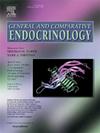毛发皮质醇作为欧亚水獭慢性应激的指标(Lutra Lutra):评估影响变异。
IF 1.7
3区 医学
Q3 ENDOCRINOLOGY & METABOLISM
引用次数: 0
摘要
糖皮质激素(如皮质醇)通过下丘脑轴分泌,以维持体内平衡并对压力作出反应,但慢性过度激活会损害健康和生存。毛发中的皮质醇积累特别有用,因为它反映了长期的压力,使其成为物种保护和管理的有价值的生理指标。然而,由于住房条件、年龄、性别、发色和疾病等变量会影响毛发皮质醇浓度(HCC),忽略这些变量可能导致慢性压力评估不准确。本研究测量了33只欧亚水獭(Lutra Lutra)(一种濒危物种)的hcc,以检查住房类型(野生与圈养)、年龄和性别是否影响hcc。结果显示,青少年HCC明显高于成人,提示年龄可能是影响HCC的一个因素。然而,HCC在性别或住房类型方面没有显著差异。此外,两名HCC异常高的个体被证实受到疾病的影响。我们建议在HCC分析中标准化年龄分类是必要的,并且还应考虑其他可能影响HCC变异性的重要因素。特别是,疾病被认为是影响HCC的一个可能因素,而这些因素可能对HCC变异性有更大的影响。虽然在住房类型和性别方面没有发现显著的差异,但这些因素可以通过涉及更广泛的住房环境和更大样本量的未来研究更清楚地确定。然而,尽管HCC有可能作为长期应激的一个有希望的指标,但本研究的一个局限性是其生理有效性尚未在欧亚水獭中得到充分验证。因此,本研究结果应谨慎解读。然而,通过分析影响HCC的关键因素,本研究为了解住房类型、性别和年龄对长期应激评估的影响提供了重要的基础数据。本文章由计算机程序翻译,如有差异,请以英文原文为准。
Hair cortisol as an indicator of chronic stress in Eurasian otters (Lutra lutra): Evaluating influencing variations
Glucocorticoids such as cortisol are secreted via the HPA axis to maintain homeostasis and respond to stress, but chronic over-activation can impair health and survival. Cortisol accumulation in the hair is particularly useful because it reflects long-term stress, making it a valuable physiological indicator for species conservation and management. However, as variables such as housing conditions, age class, sex, hair color, and disease can affect hair cortisol concentration (HCC), ignoring these variables may lead to inaccuracies in chronic stress evaluation. This study measured HCCs in 33 Eurasian otters (Lutra lutra), an endangered species, to examine whether housing type (wild vs. captive), age, and sex affect HCCs. The results showed that juveniles had significantly higher HCCs than adults, suggesting that age may be a factor influencing HCC. However, no significant differences in HCC were found with respect to sex or housing type. Additionally, two of the individuals with exceptionally high HCC were confirmed to have been affected by disease. We propose that standardizing age class in HCC analysis is necessary, and that other important factors potentially influencing HCC variability should also be considered. In particular, disease has been suggested as a possible factor affecting HCC, and such factors may have an even greater impact on HCC variability. Although no significant differences were found regarding housing type and sex, these factors may be more clearly identified through future studies involving a broader range of housing environments and a larger sample size. However, despite the potential of HCC as a promising indicator of long-term stress, a limitation of this study is that its physiological validity has not yet been sufficiently verified in Eurasian otters. Therefore, the results of this study should be interpreted with caution. Nevertheless, by analyzing key factors influencing HCC, this study provides important foundational data for understanding the effects of housing type, sex, and age on long-term stress assessment.
求助全文
通过发布文献求助,成功后即可免费获取论文全文。
去求助
来源期刊

General and comparative endocrinology
医学-内分泌学与代谢
CiteScore
5.60
自引率
7.40%
发文量
120
审稿时长
2 months
期刊介绍:
General and Comparative Endocrinology publishes articles concerned with the many complexities of vertebrate and invertebrate endocrine systems at the sub-molecular, molecular, cellular and organismal levels of analysis.
 求助内容:
求助内容: 应助结果提醒方式:
应助结果提醒方式:


